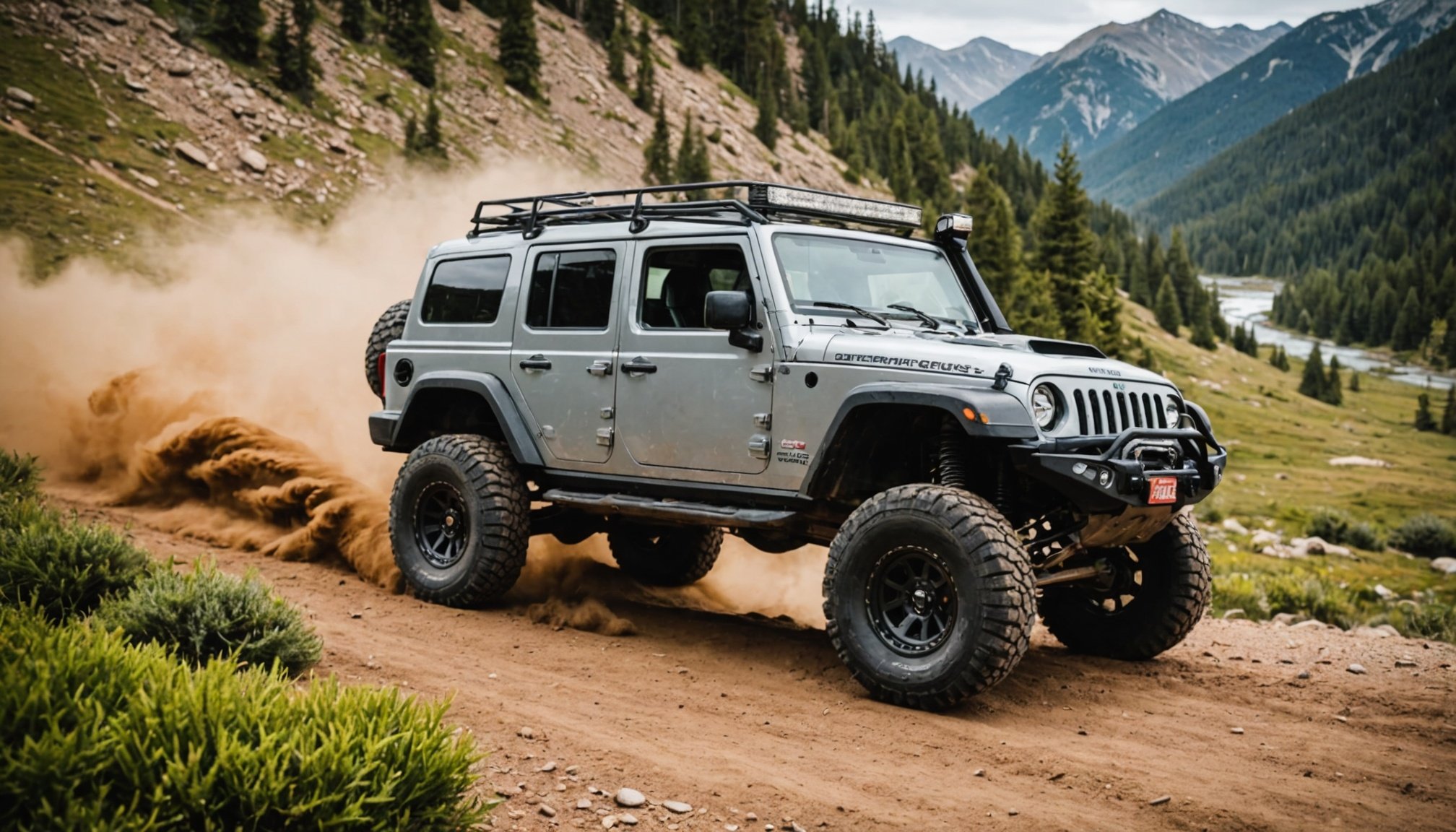Ultimate Guide to Differential Care: Ensure Safe Off-Roading Adventures with Your Vehicle
Understanding the Importance of Differentials in Off-Roading
When it comes to off-roading, your vehicle’s differentials are among the most critical components that ensure you can navigate through various terrains safely and efficiently. Differentials are essentially the gears that allow your vehicle’s wheels to rotate at different speeds, which is essential for maintaining traction and stability, especially on uneven or slippery surfaces.
What are Differentials?
Differentials are found in the front and rear axles of your vehicle and in the transfer case for four-wheel drive (4WD) vehicles. They enable the wheels on an axle to rotate at different speeds, which is crucial for cornering and navigating rough terrain. For example, when you’re driving on a rocky trail, the wheels on one side of the vehicle may need to rotate faster than those on the other side to maintain traction and prevent wheelspin or loss of control[2].
This might interest you : Unraveling how tire compositions influence vehicle performance in diverse uk weather conditions
Why Differential Care is Essential
Ignoring your vehicle’s differentials can lead to serious issues, including reduced traction, increased wear on other components, and even complete failure of the differential itself. Here’s what can happen if you neglect differential care:
- Reduced Traction: Dirty or low differential fluids can lead to poor lubrication, causing the gears to wear down faster and reducing the vehicle’s ability to maintain traction on challenging terrains.
- Increased Wear: Neglecting differential maintenance can put additional stress on other components like the transmission, transfer case, and even the engine.
- Complete Failure: In severe cases, a neglected differential can fail entirely, leaving you stranded in the middle of nowhere.
Regular Maintenance of Differentials
To ensure your differentials remain in top condition, regular maintenance is key.
Have you seen this : Unveiling how vehicle weight affects braking efficacy on the uk’s most challenging steep descents
Checking and Changing Differential Fluids
Differential fluids are the lifeblood of your vehicle’s differentials. Here’s how to keep them in good shape:
- Check Fluid Levels: Regularly check the fluid levels in your differentials. Low levels can indicate leaks or excessive wear.
- Change Fluids: Replace differential fluids at the intervals recommended by your vehicle’s manufacturer. For example, Suzuki recommends changing the differential fluids in your Jimny at regular intervals to ensure smooth performance[1].
Inspecting for Leaks and Damage
Regular inspections can help you identify potential issues before they become major problems.
- Look for Leaks: Check for any signs of leaks around the differentials. Oil spots or drips can indicate a problem.
- Inspect for Damage: After every off-road adventure, inspect the differentials for any signs of damage, such as dents or cracks.
Choosing the Right Differential Fluids
Not all differential fluids are created equal. Here’s what you need to know:
Types of Differential Fluids
Different types of differential fluids are suited for different driving conditions.
- Synthetic vs. Conventional: Synthetic fluids offer better lubrication and protection in extreme temperatures and conditions. They are a good choice for frequent off-roaders.
- High-Performance Fluids: Some fluids are specifically designed for high-performance off-roading and offer enhanced protection against wear and tear.
Table: Comparison of Differential Fluids
| Type of Fluid | Temperature Range | Lubrication Properties | Cost |
|---|---|---|---|
| Conventional | Moderate | Good | Lower |
| Synthetic | Extreme | Excellent | Higher |
| High-Performance | Extreme | Superior | Highest |
Upgrading Your Differentials for Enhanced Off-Road Performance
If you’re serious about off-roading, upgrading your differentials can significantly enhance your vehicle’s performance.
Locking Differentials
Locking differentials ensure that both wheels on an axle receive equal power, which is crucial for navigating very challenging terrains.
- Manual Locking: Manual locking differentials require the driver to engage them when needed. They are more affordable but require more driver input.
- Automatic Locking: Automatic locking differentials engage automatically when the vehicle detects a loss of traction. They are more convenient but generally more expensive.
Limited-Slip Differentials
Limited-slip differentials are designed to send more power to the wheel with the most traction, helping to maintain stability and control.
- Clutch-Type: Clutch-type limited-slip differentials use clutches to transfer power between the wheels.
- Viscous-Type: Viscous-type limited-slip differentials use a viscous fluid to transfer power.
Safety and Recovery Considerations
Off-roading can be unpredictable, and being prepared is crucial for safety and recovery.
Safety First
Always prioritize safety when off-roading:
- Wear Protective Gear: Ensure all passengers wear seatbelts and consider additional protective gear like helmets.
- Carry Recovery Gear: Always carry recovery gear such as winches, tow straps, and shackles. Knowing how to use them is equally important[5].
Recovery Techniques
Knowing how to recover your vehicle safely is essential:
- Winching: Use a winch to pull your vehicle out of sticky situations. Make sure to follow proper winching techniques to avoid damage or injury.
- Towing: If you need to tow your vehicle, use a tow strap and ensure both vehicles are securely attached.
Terrain-Specific Modifications and Accessories
Different terrains require different modifications and accessories to ensure your vehicle is well-equipped.
Terrain Management Systems
Modern off-road vehicles often come with terrain management systems that adjust settings like throttle response, traction control, and suspension to optimize performance for specific terrains.
- Ford’s G.O.A.T.: The Ford Bronco’s G.O.A.T. system offers pre-set modes for different terrains, such as sand, mud, and rock crawl[3].
- Jeep Selec-Terrain®: The Jeep Wrangler and Grand Cherokee feature the Selec-Terrain® system, which adjusts power distribution and suspension settings based on the terrain.
Lift Kits and Suspension Upgrades
Lift kits and suspension upgrades can significantly enhance your vehicle’s off-road capabilities.
- Lift Kits: Lift kits provide additional ground clearance, which is essential for navigating rocky or muddy terrains. However, they can affect the vehicle’s stability on the road[4].
- Suspension Upgrades: Heavy-duty suspension kits can enhance ride comfort and stability on rough terrains. For example, the Ford Bronco’s HOSS system adjusts in real-time to handle rough terrain.
Practical Tips for Off-Roading with Your Vehicle
Here are some practical tips to keep in mind when off-roading with your vehicle:
Tire Pressure and Choice
- Check Tire Pressure: Regularly check tire pressure and adjust it according to the terrain. Lower pressure can provide better grip in off-road conditions, but make sure to reinflate for highway driving[1].
- Choose the Right Tires: Opt for all-terrain or mud-terrain tires suited to your preferred off-road adventures.
Weight Distribution
- Pack Smartly: Distribute weight evenly, especially when carrying gear for long trips. Avoid overloading roof racks or the rear of the vehicle[1].
Post-Adventure Care
- Inspect for Damage: After every off-road trip, inspect your vehicle for any signs of damage, such as dents, scratches, or leaks.
- Wash Thoroughly: Pay special attention to the undercarriage and remove any mud, salt, or grime to prevent rust and corrosion[1].
Taking care of your vehicle’s differentials is crucial for safe and enjoyable off-road adventures. By following the tips outlined above, you can ensure your differentials remain in top condition, enhancing your vehicle’s performance and longevity.
Final Tips
- Stay Updated: Keep up with the latest off-road trends and technologies to continuously improve your vehicle’s performance.
- Respect the Terrain: Always respect the terrain and follow rules and regulations, especially in national parks, to preserve the natural beauty and wildlife[5].
By investing time and effort into differential care and other essential maintenance tasks, you can enjoy countless road adventures with your vehicle, whether you’re navigating the great outdoors or tackling challenging trails in a national park. Remember, with the right care and preparation, your vehicle will be ready to take on any terrain you throw at it.











